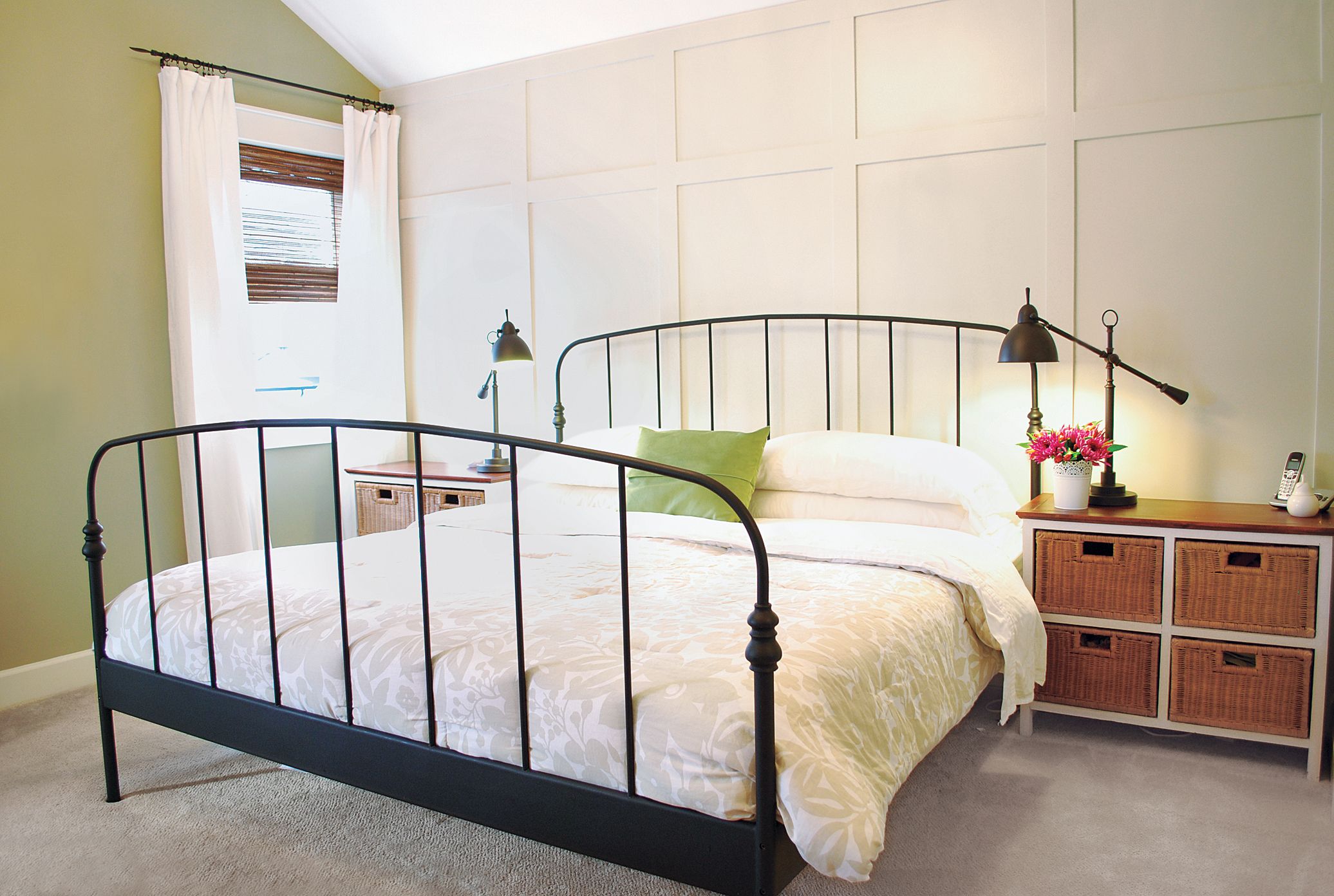We may be compensated if you purchase through links on our website. Our Reviews Team is committed to delivering honest, objective, and independent reviews on home products and services.
Project details
Skill
Cost
Estimated Time
Creating a faux-paneled accent wall is an affordable and stylish way to transform a boring room into an eye-catching space. This DIY project can be completed in a weekend, making it perfect for homeowners looking to upgrade their space without a major time commitment or a huge budget. In this guide, we’ll walk you through the process of designing and installing a faux-paneled accent wall from start to finish.
Understanding Faux Paneling and Its Benefits
Faux paneling is a decorative technique that mimics the look of traditional wood paneling using trim pieces applied directly to your wall. This method uses less expensive materials than wood paneling, has a simple installation process, and can be customized to fit any room size or style. Once installed and painted, faux paneling requires minimal upkeep.
Essential Tools and Materials for Your Project
Before you begin, gather the following tools and materials for your project:
- Miter box and backsaw
- Brad nailer
- Measuring tape
- Level
- Pencil
- Caulking gun
- Sandpaper
- Paintbrushes and rollers
- Stud finder
- MDF or wood trim (for rails and stiles)
- Wood glue
- Brad nails
- Joint compound
- Paintable caulk
- Primer
- Paint
- Sanding block (optional, for better grip and ease of sanding)
The specific amount of trim needed will depend on your wall dimensions and design plan. It’s always a good idea to purchase slightly more material than you think you’ll need to account for mistakes or adjustments.
Planning Your Faux Paneled Accent Wall
Proper planning will help you achieve a professional-looking faux-paneled accent wall. Take the time to carefully measure and design your layout before making any cuts or purchases.
Measuring Your Wall
Start by measuring the height and width of your wall. Note any obstacles, such as outlets, switches, or vents, that you’ll need to work around.
Creating a Diagram
This is optional but we recommend you use graph paper or design software to create a scaled diagram of your wall. This visual representation will help you determine the number and size of panels that will look best in your space.
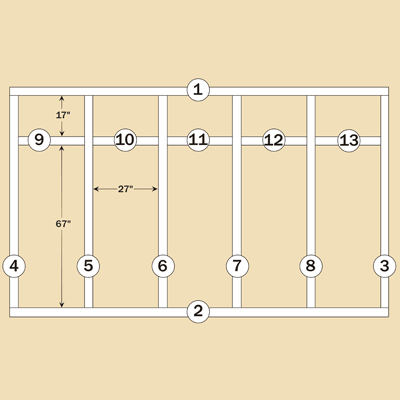
Calculating Panel Dimensions
To determine the ideal panel dimensions for your wall, follow these steps:
- Decide on the number of panels you want (four to six typically look best).
- Calculate the total width of your trim pieces.
- Subtract the trim width from the total wall width to find the remaining space.
- Divide the remaining space by the number of panels to determine panel width.
For example, if your wall is 13 feet wide and you want five panels using 3½-inch wide trim, your calculation might look like this:
- Total trim width: 6 pieces x 3½ inches = 21 inches
- Remaining space: 156 inches (13 feet) – 21 inches = 135 inches
- Panel width: 135 inches ÷ 5 panels = 27 inches per panel
Adjust these numbers as needed to achieve a balanced look that complements your room’s proportions.
Designing for Different Styles
Once you have your measurements, you can choose a paneling style that suits your taste.
Traditional Elegance
For a classic or traditional look, opt for evenly spaced panels with symmetrical proportions. This style works well in formal living rooms or dining areas.
Modern Minimalism
If you prefer a more contemporary feel, consider larger panels with fewer sections. Minimalist styles often include clean, straight lines with little to no additional detailing, which suits spaces like master bedrooms or modern home offices.
Rustic Charm
For a rustic or farmhouse vibe, wider boards with a distressed finish can be a great choice. These panels add a cozy, lived-in feel to kitchens, entryways, or casual living areas.
Step-by-Step Guide to Installing Faux Panels
With your plan in place, it’s time to bring your faux-paneled accent wall to life. Follow these steps for a successful installation.
Mocking Up Panel Spacing
Use a pencil to lightly mark the positions of your rails and stiles on the wall. This visual guide will help with accurate placement during installation.
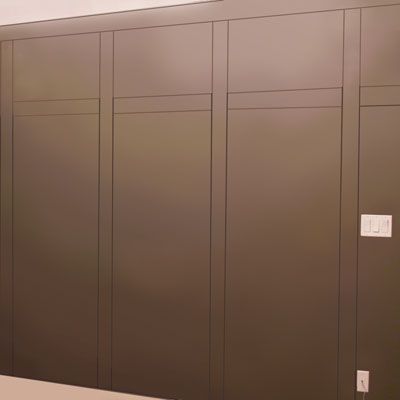
Installing the Top and Bottom Rails
Begin by installing the top horizontal rail. Apply wood glue to the back of the trim and secure it to the wall using a brad nailer. If your existing baseboard doesn’t match your trim, install a bottom rail in the same manner. Leave the middle rail for later.
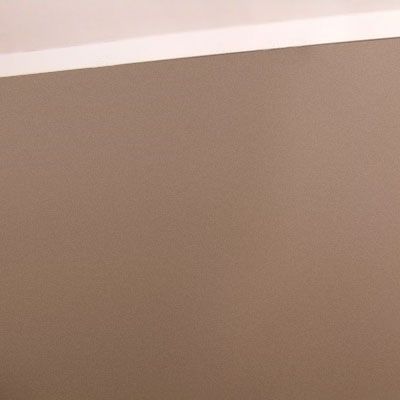
Mounting the Vertical Stiles
With the top and bottom rails in place, it’s time to install the vertical stiles. Measure and cut each stile to fit snugly between the rails. For the best fit, scribe each piece and trim with a handsaw if necessary. Apply glue and nail each stile in place, working your way across the wall.
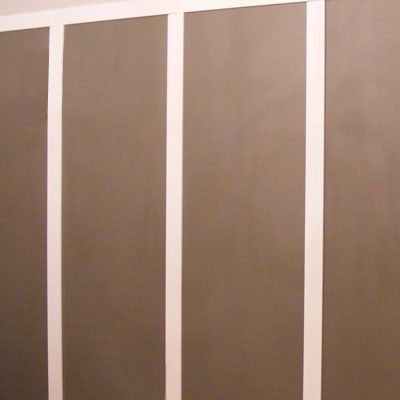
Adding the Middle Rail
Once all vertical stiles are installed, measure and cut pieces for the middle rail. These shorter sections will fit between the stiles. Scribe and cut each piece for a precise fit, then glue and nail them in place. Allow the glue to dry overnight before proceeding to the final steps.
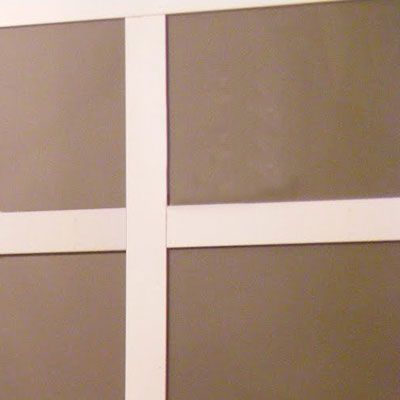
Finishing Touches for a Professional Look
The final steps include filling nail holes, caulking, and painting.
Filling Nail Holes and Sanding
Use joint compound to fill all nail holes and any small gaps between the trim and wall. Once dry, sand these areas smooth to create a seamless surface.
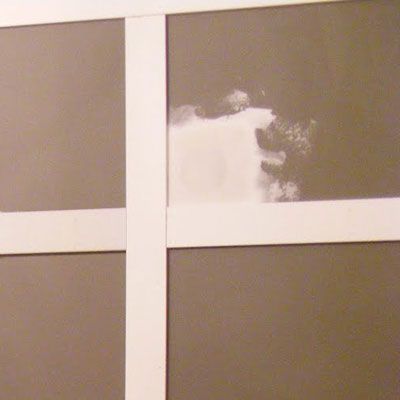
Sealing Seams with Caulk
Apply a thin bead of paintable caulk along all seams where the trim meets the wall. This step helps prevent cracks and gives your faux paneling a more authentic look.
Priming and Painting
After the caulk has dried, wipe down the entire wall to remove any dust or debris. Apply a coat of primer. Once the primer is dry, paint your faux paneled wall in your chosen color. You may need multiple coats for full coverage, especially if you’re making a dramatic color change.
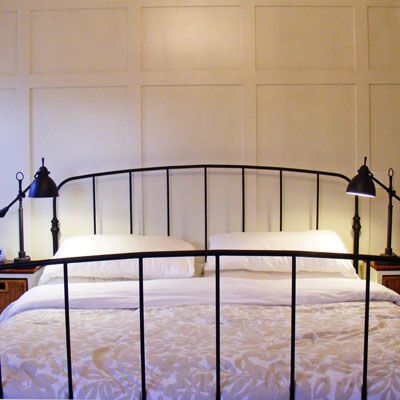
Advanced Finishes
To elevate the look of your faux paneled wall, add specialized finishes like decorative molding and two-tone paint.
Decorative Molding
Adding decorative molding to the edges of your panels can give them a more sophisticated and intricate appearance. This is ideal for spaces you want to appear luxurious, such as a master suite or formal dining room.
Faux Wood Grain
For an added touch of realism, you can use a wood-graining tool and paint to create a faux wood grain texture on your panels. This technique works well in rustic or traditional settings and can make your wall look like it’s made from real wood.
Two-Tone Paint
Applying a two-tone paint scheme, where the panels are one color and the trim is another, can give your wall depth and visual interest. This painting style is a great choice for modern and eclectic interior designs.
Alternative Faux-Paneling Techniques
While the method described above is a classic approach to faux paneling, there are other techniques you can explore to achieve different looks.
Using Adhesive Strips
For a quicker installation, consider using adhesive strips instead of nails and glue. This method is less permanent and can be a good option for renters or those who like to change their decor frequently.
Creating a Board and Batten Look
Board and batten is a popular variation of faux paneling that uses wider boards for a more rustic or farmhouse-style appearance. This is an excellent option for those looking to install shiplap walls without the complexity of true shiplap.
Troubleshooting Common Faux Paneling Issues
Even with careful planning, you may encounter some challenges during your faux paneling project. Here are solutions to common issues.
Dealing with Uneven Walls
If your walls aren’t perfectly flat, you may notice gaps between the trim and the wall. Use wood shims behind the trim to level it out, then fill any remaining gaps with caulk before painting.
Fixing Gaps Between Panels
For gaps that appear between panels after installation, use wood filler or caulk to create a seamless look. Sand smooth and touch up with paint as needed.
Maintenance and Care for Your Faux Paneled Wall
Dust your new faux paneled wall regularly with a soft cloth or duster. For a deeper clean, use a damp cloth with mild soap, being careful not to oversaturate the trim. Touch up paint as needed to keep your wall looking fresh.
If you want to add more character to your walls, consider installing beadboard wainscoting as a complementary project to your faux paneled accent wall.
